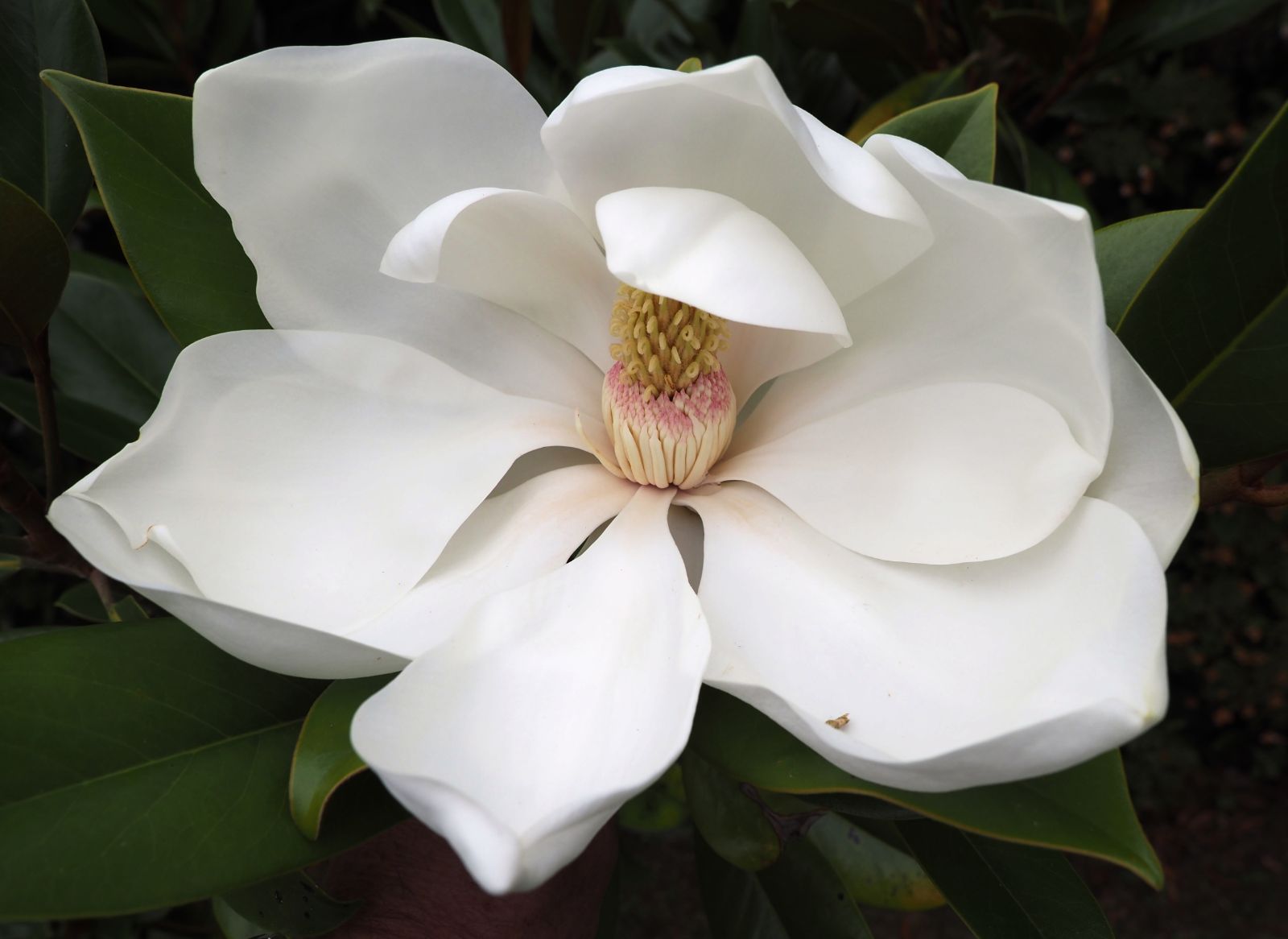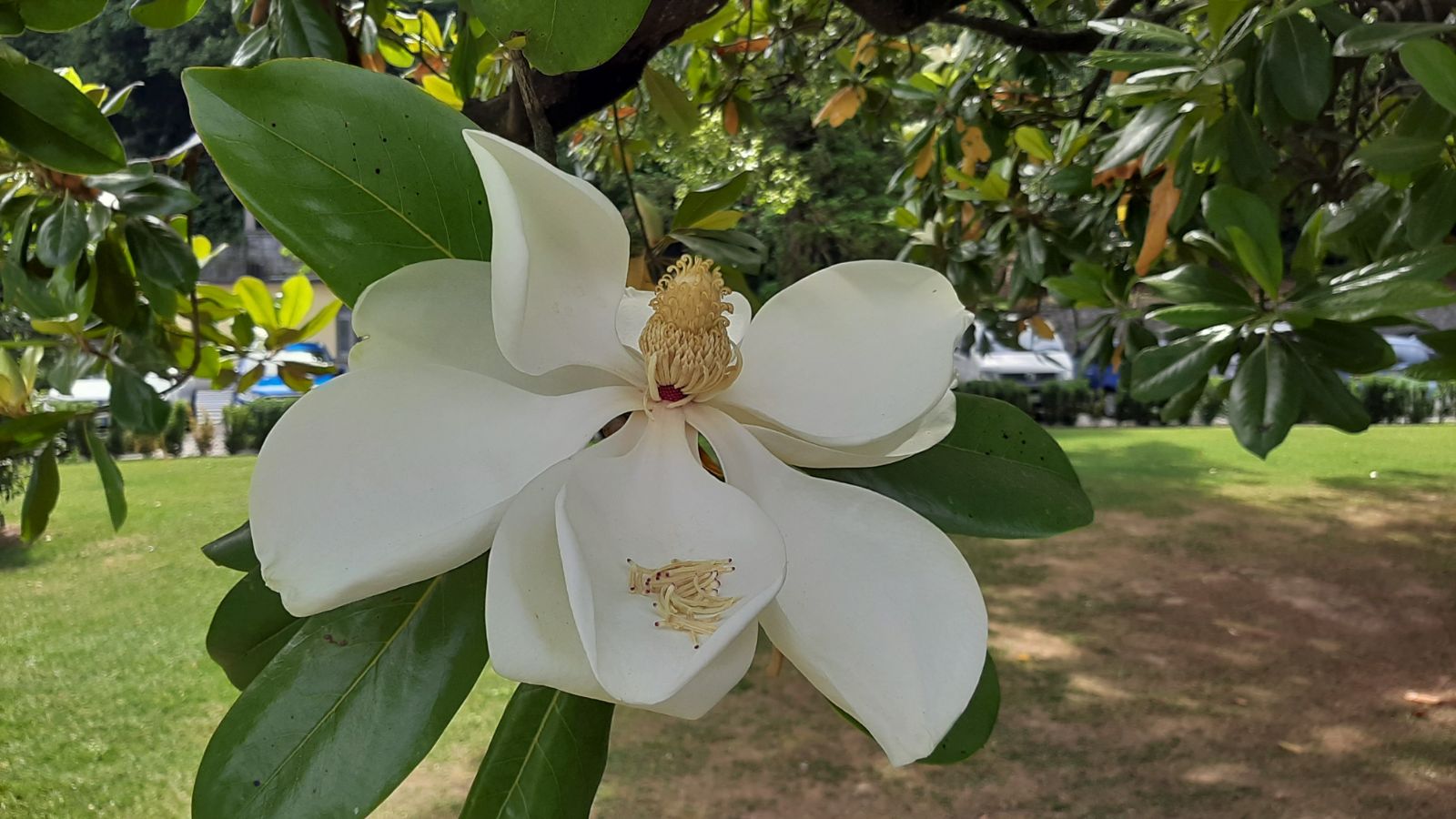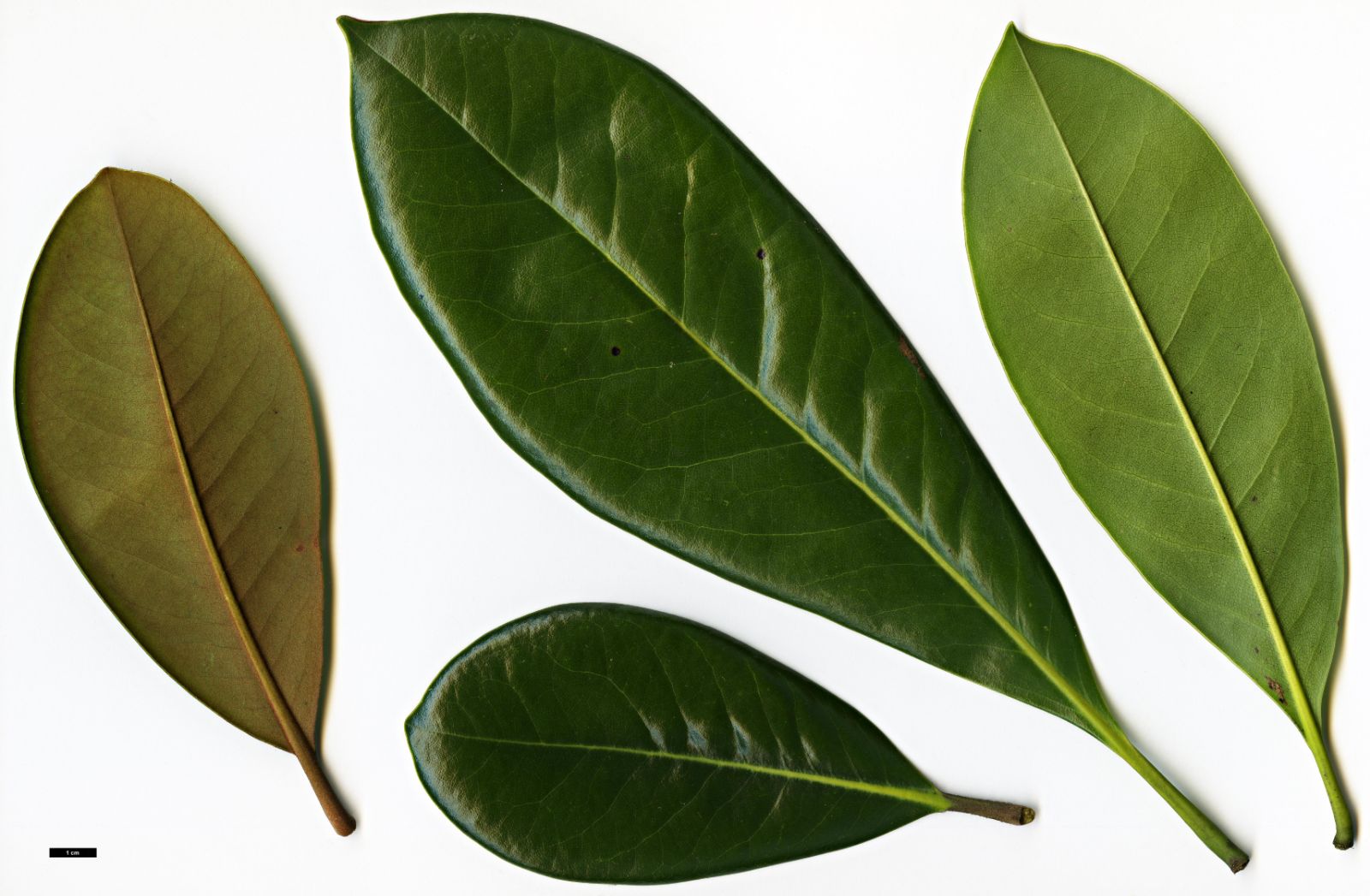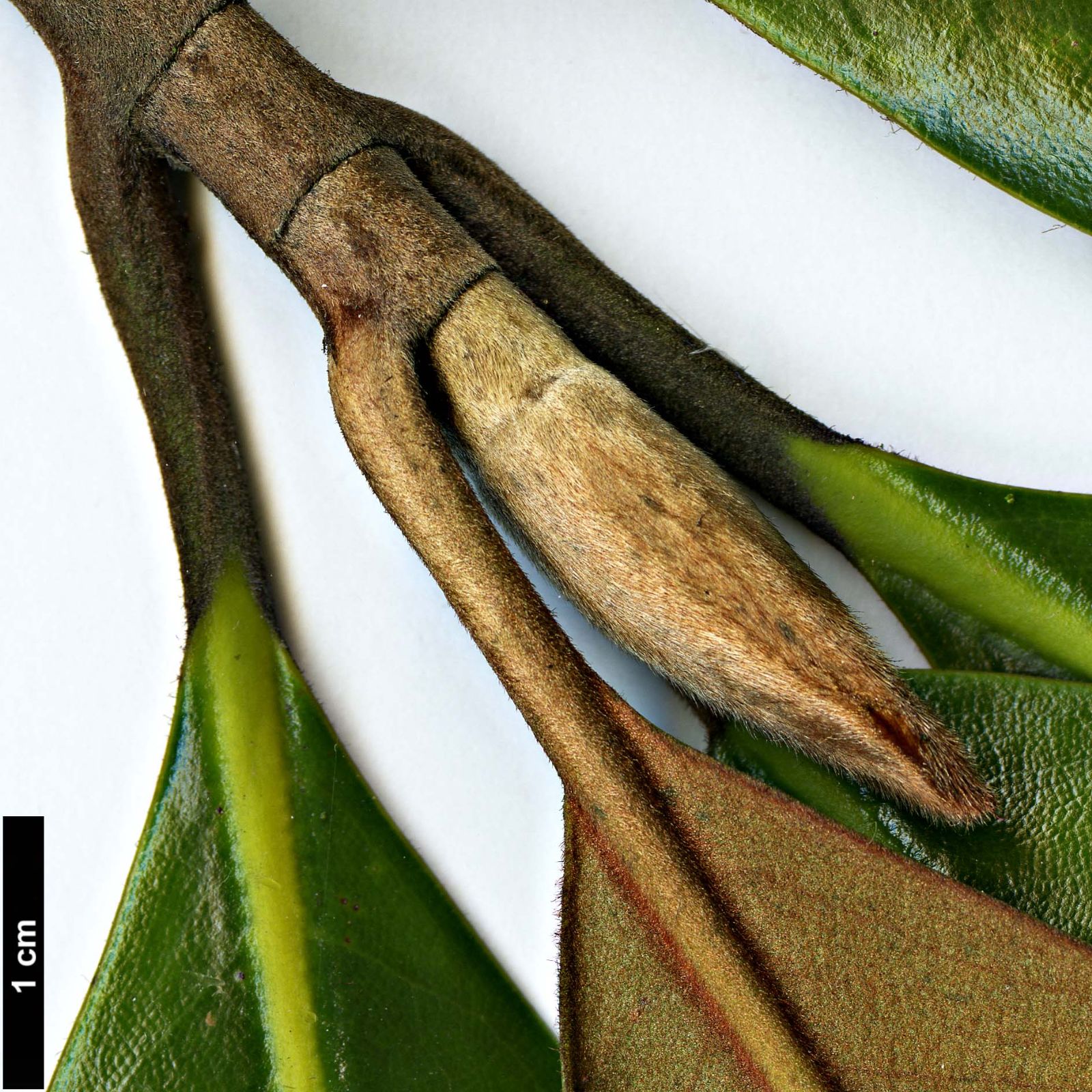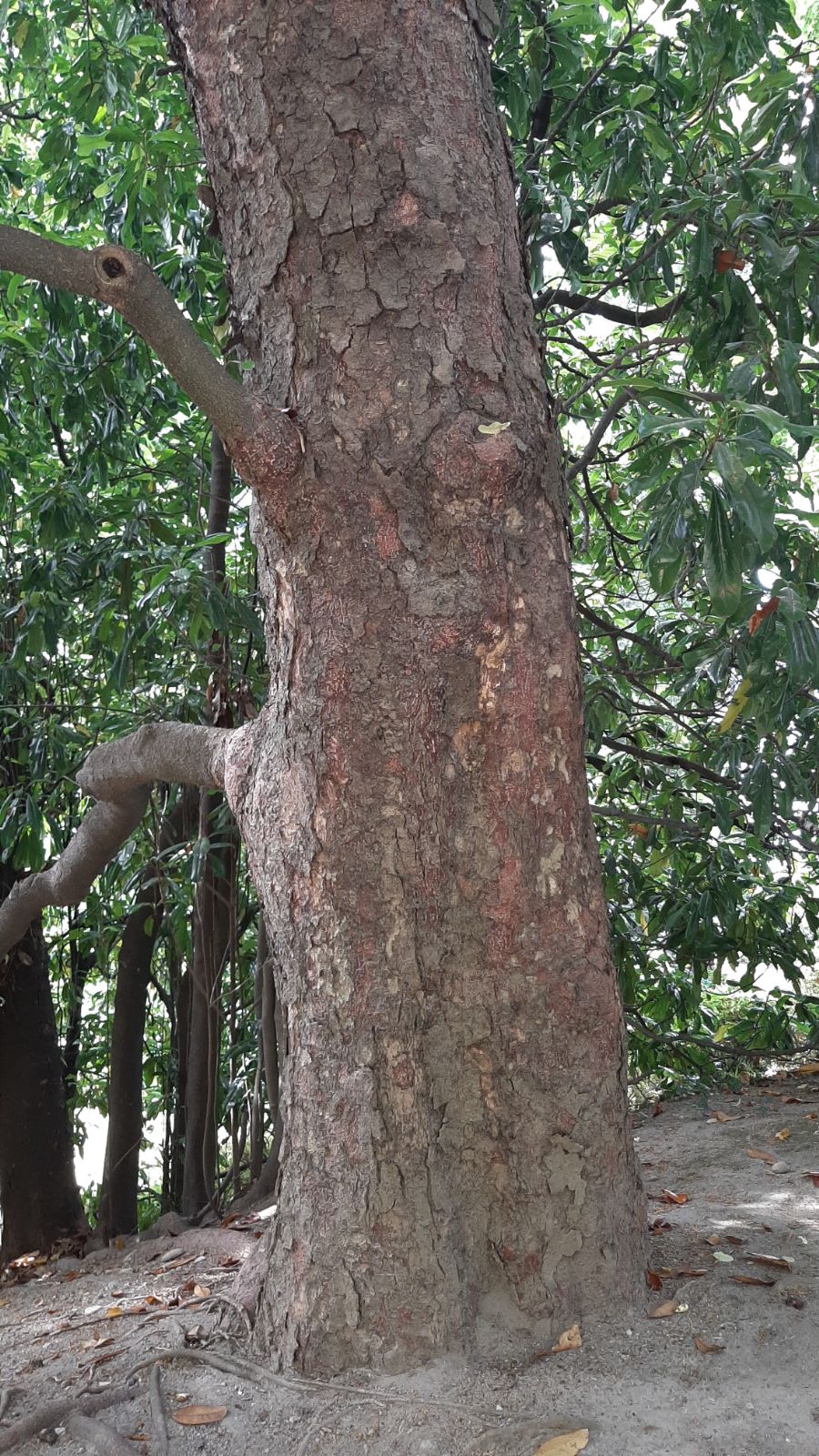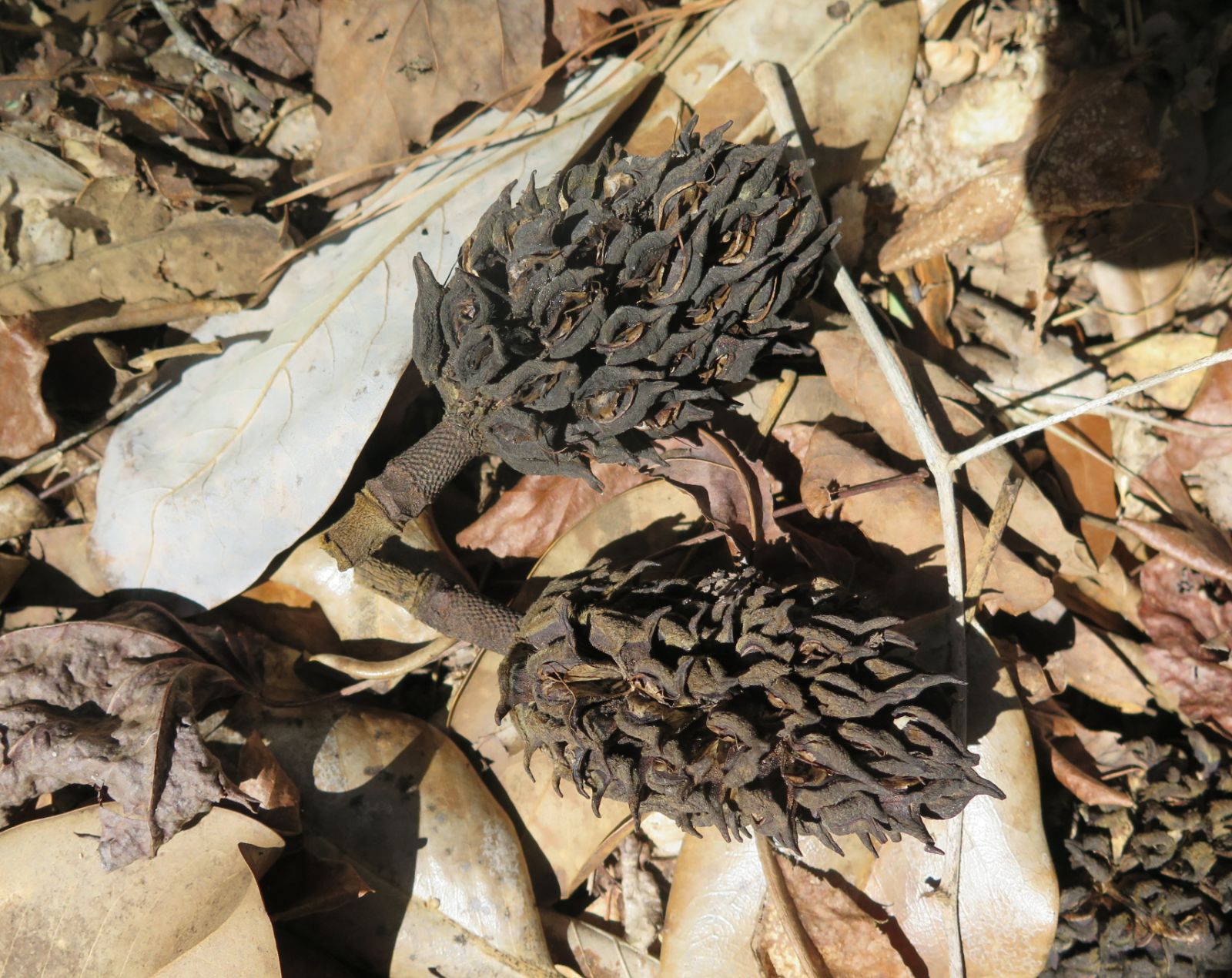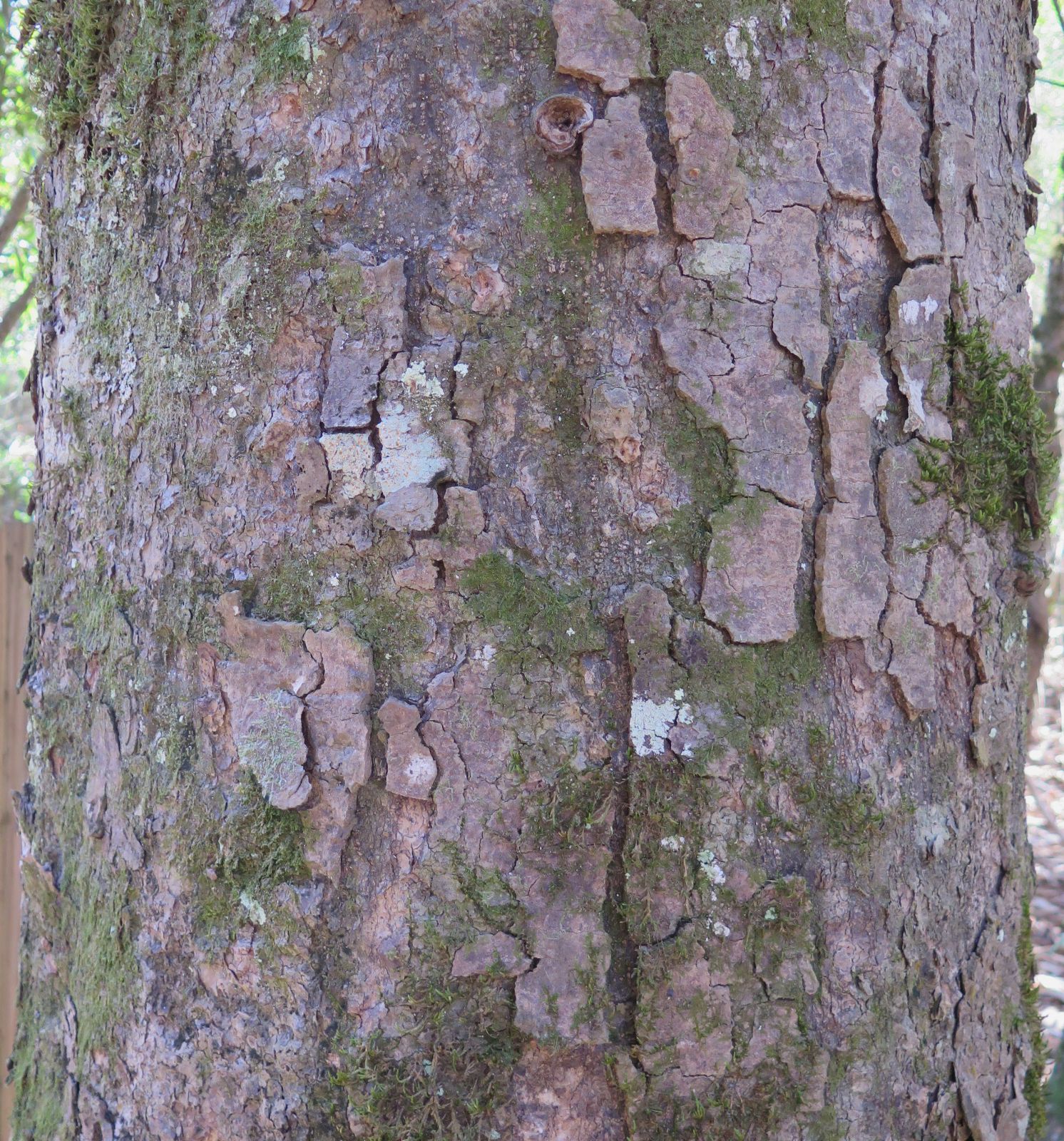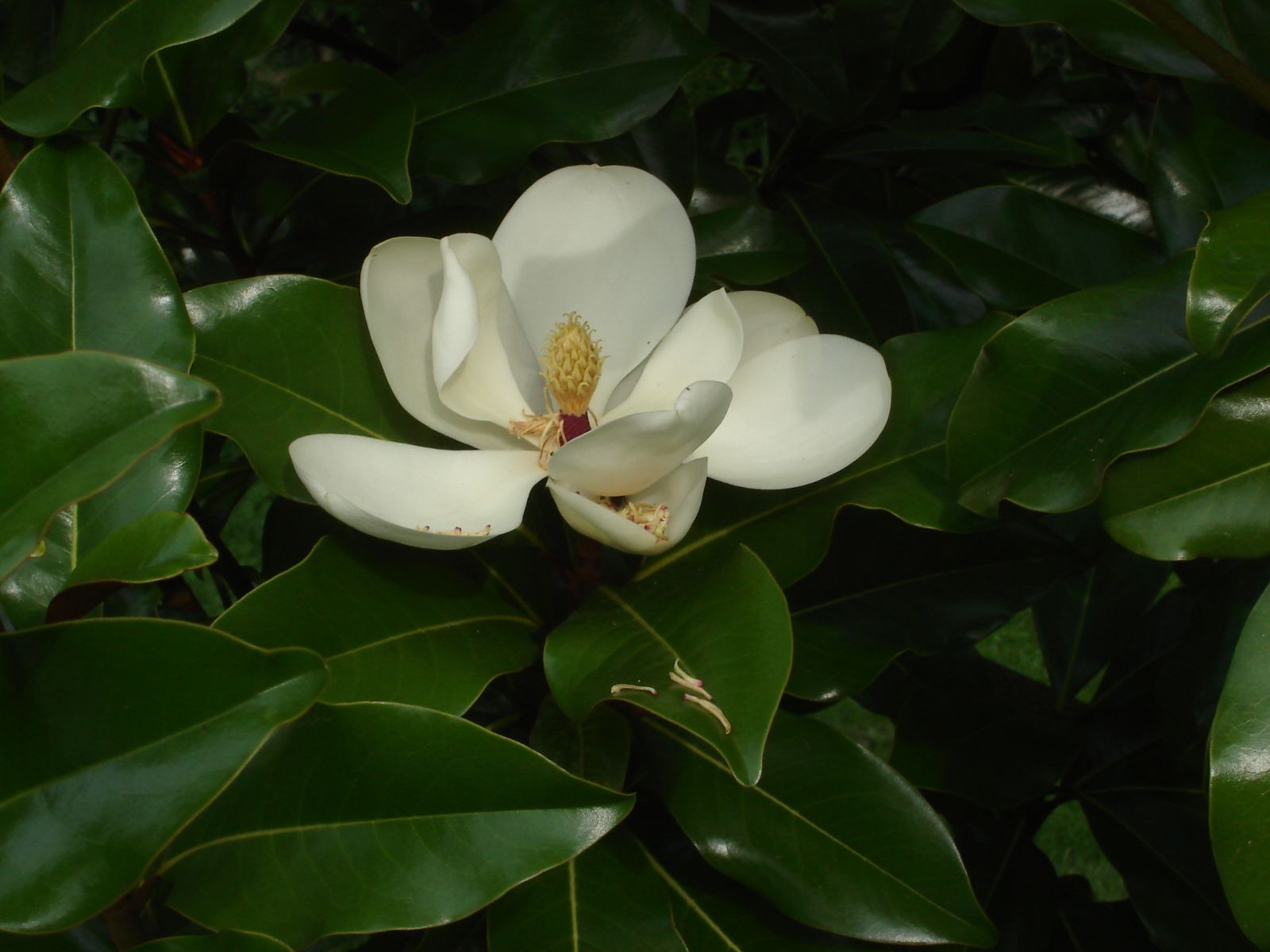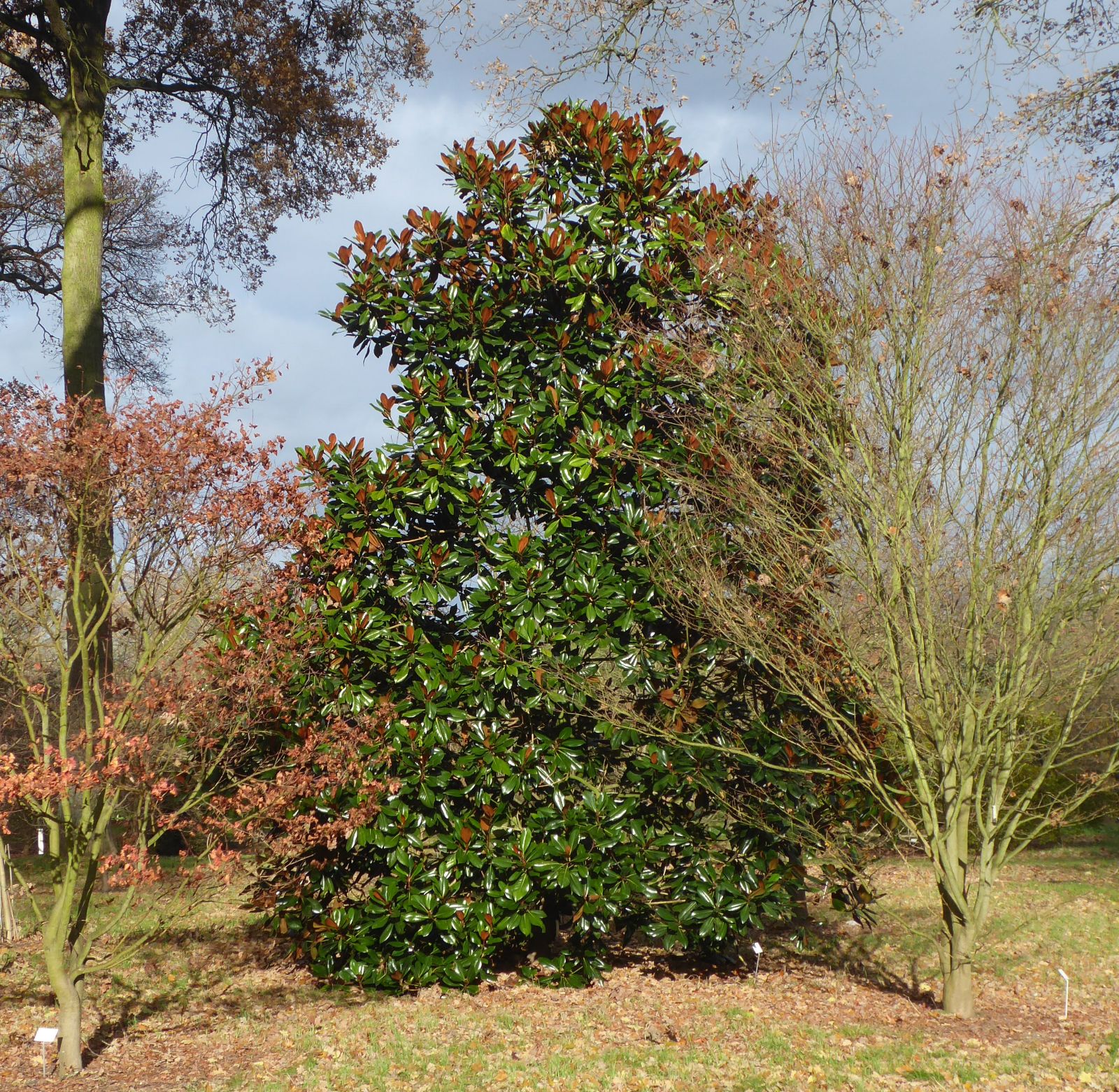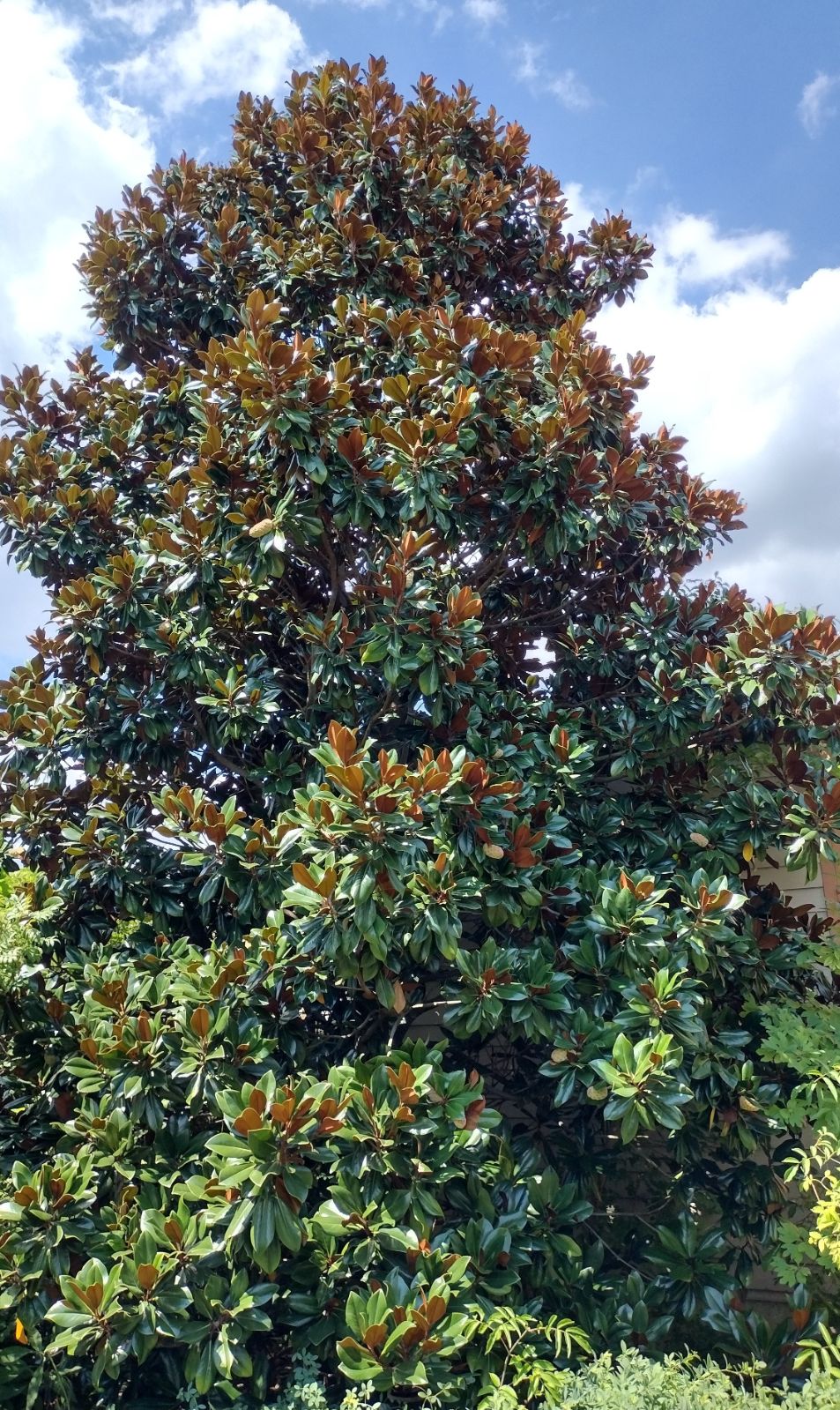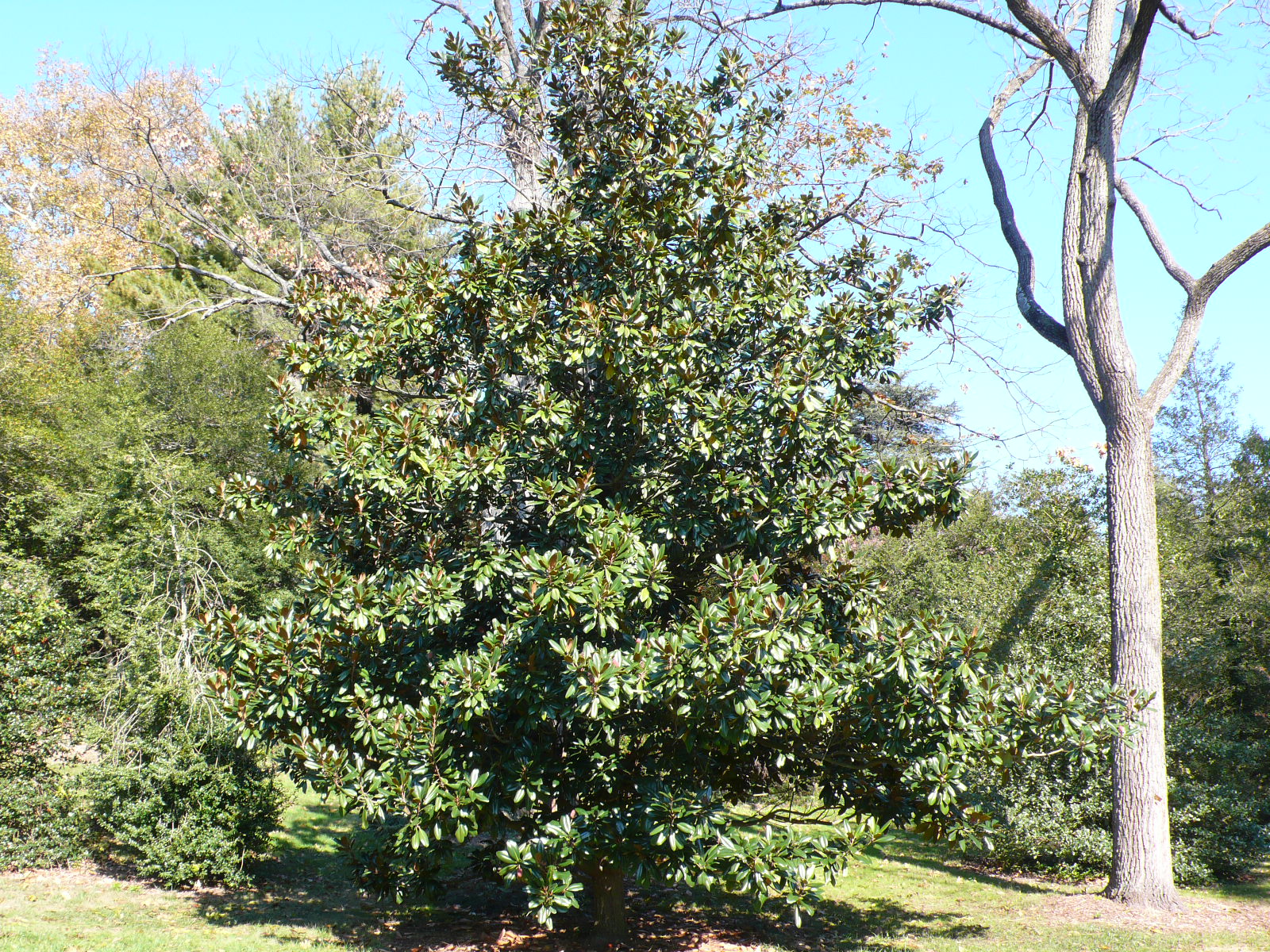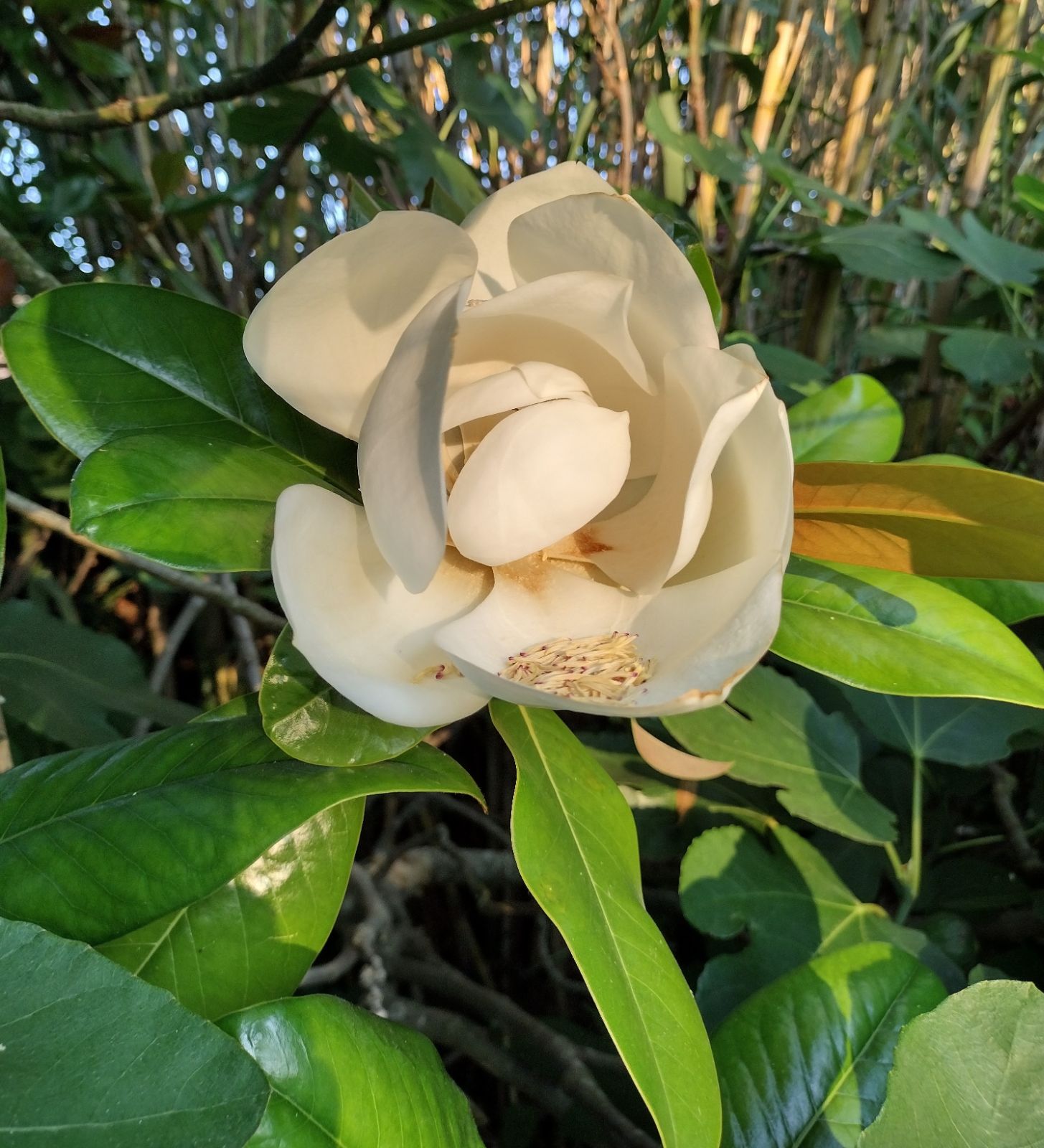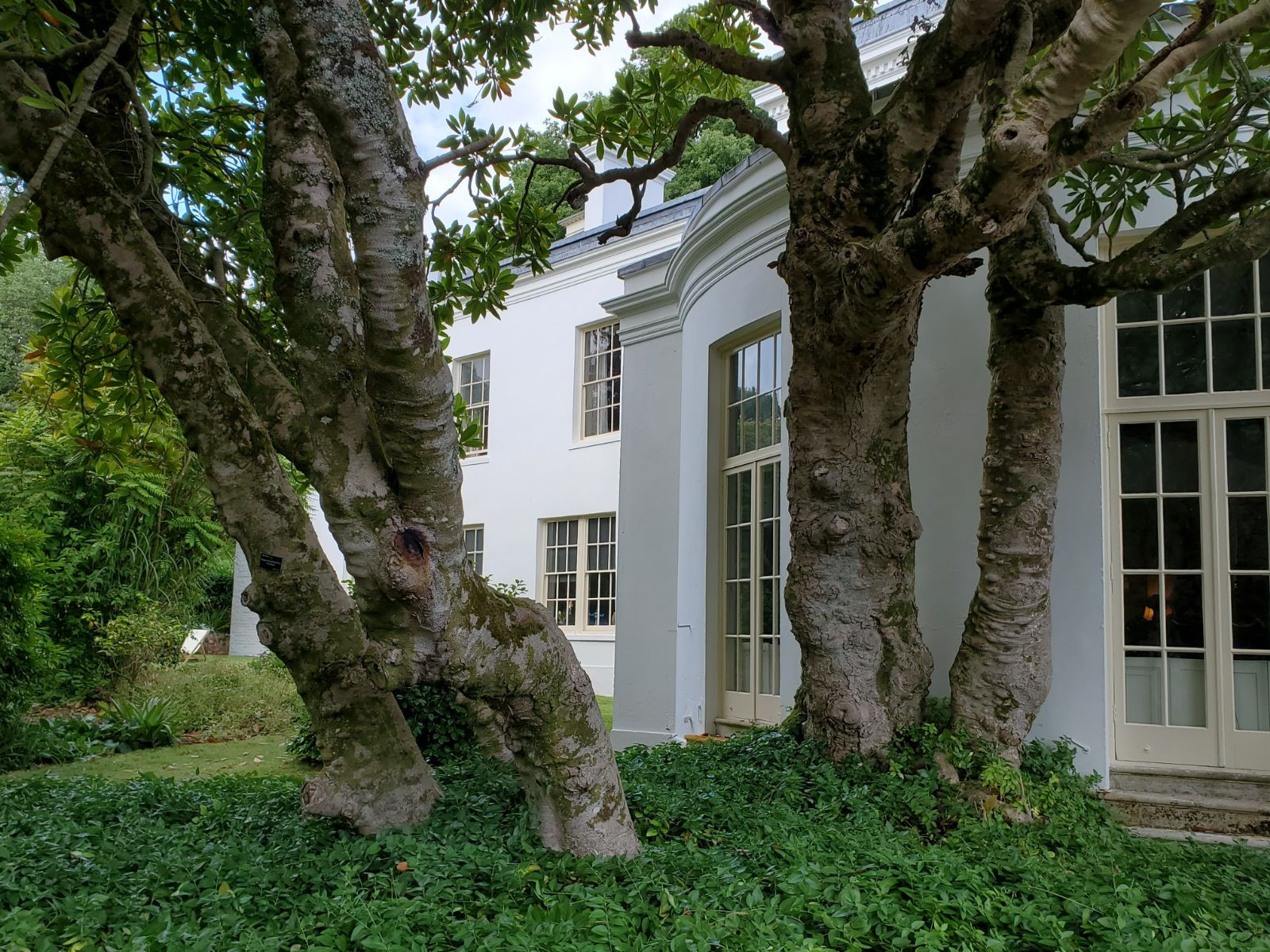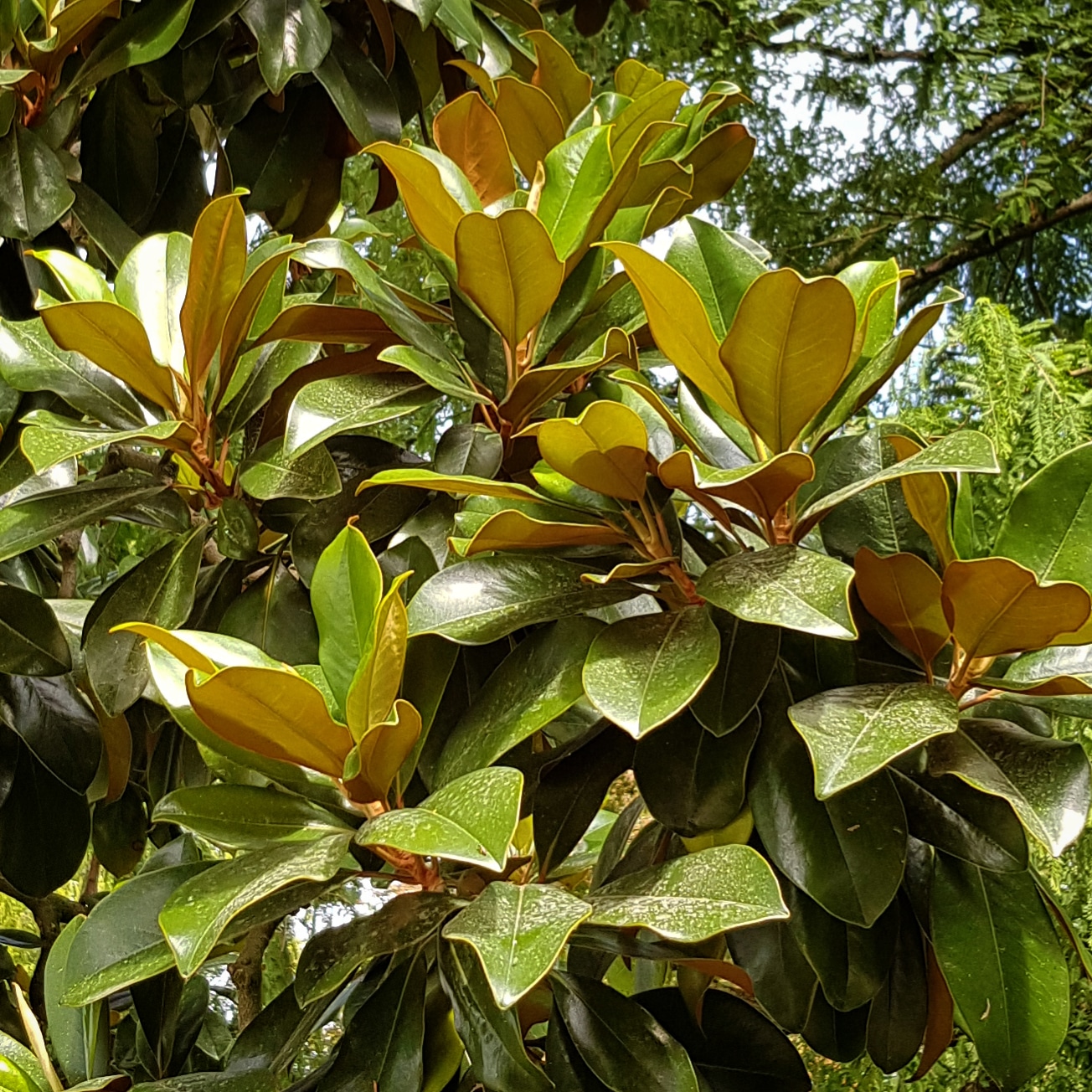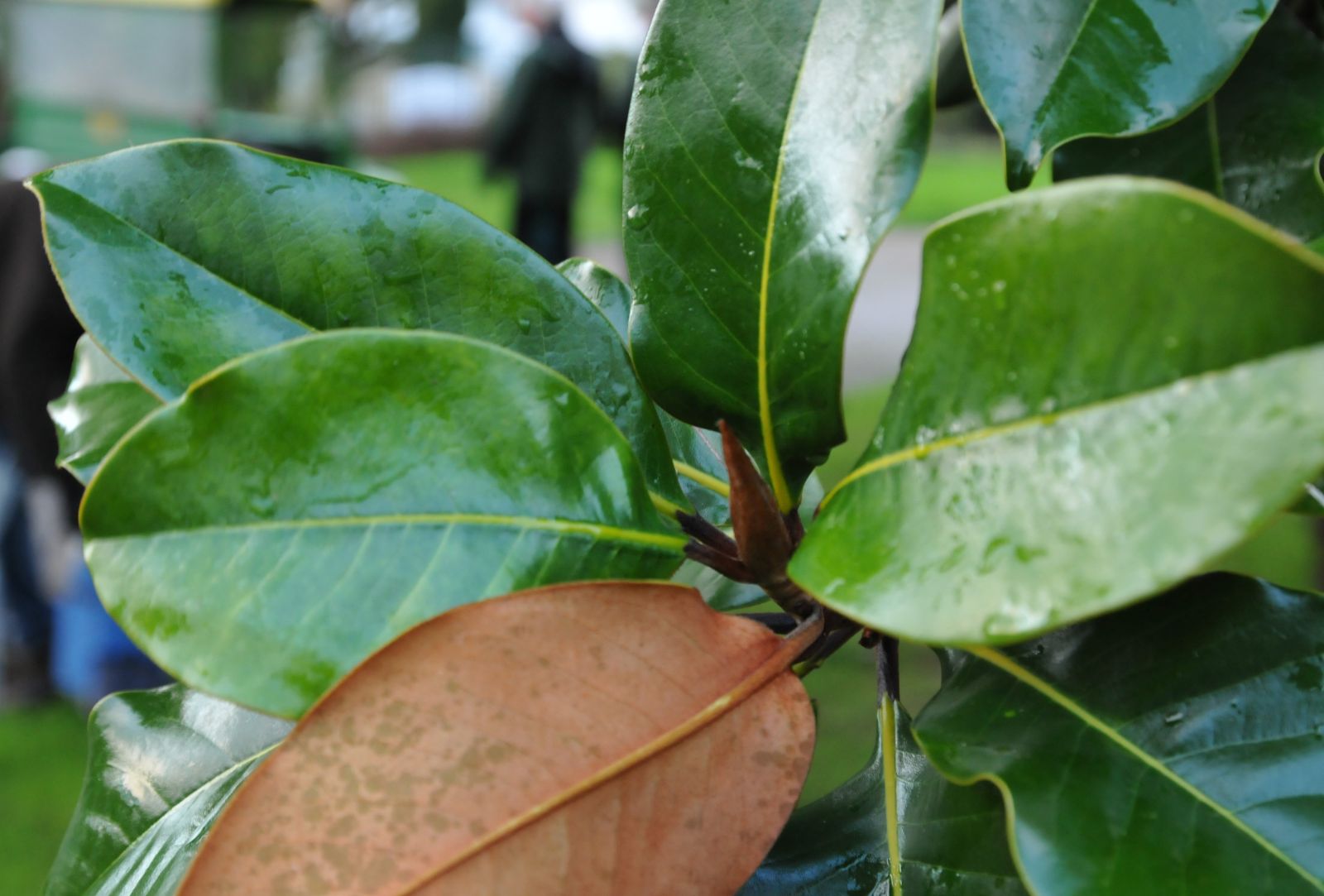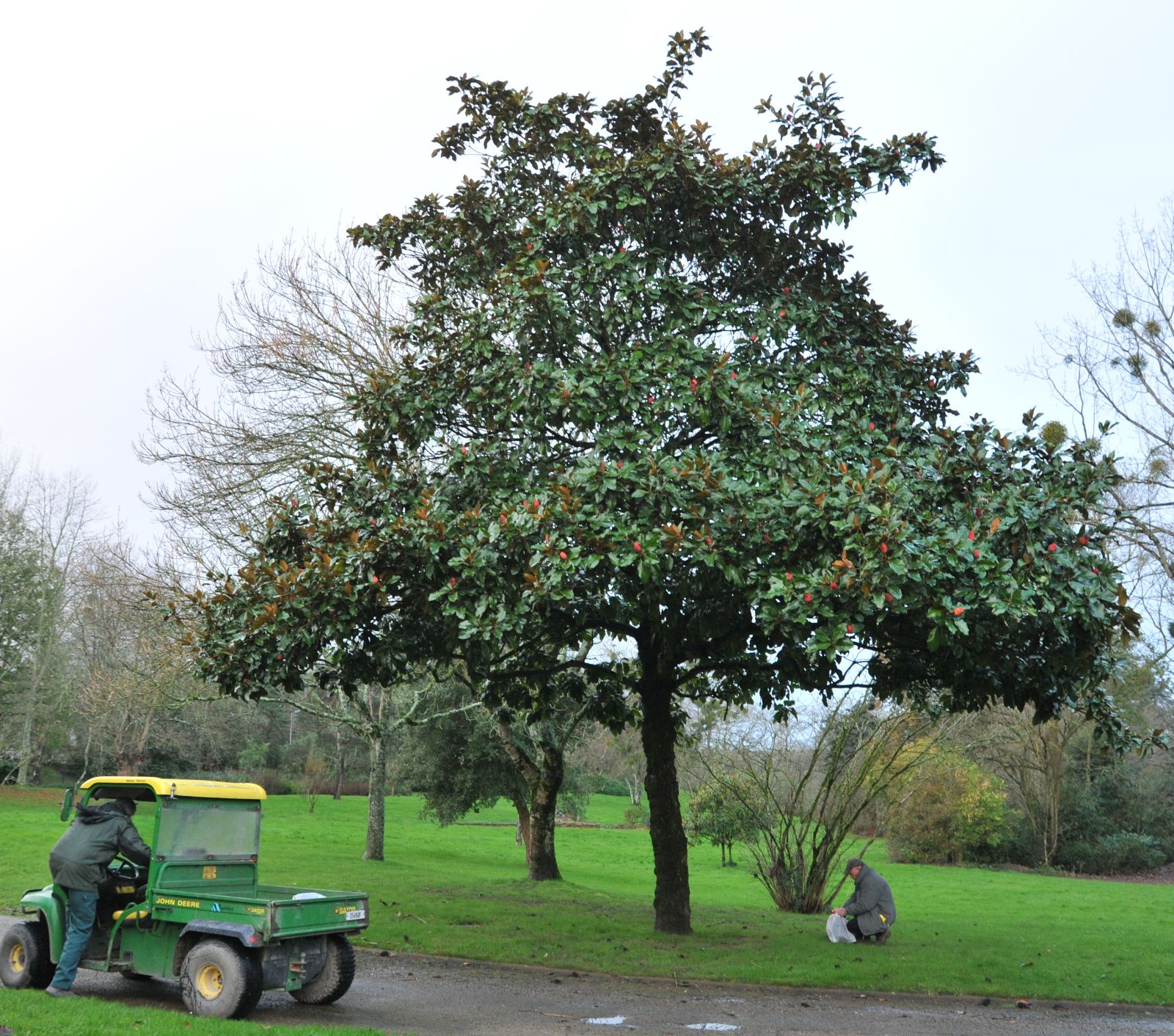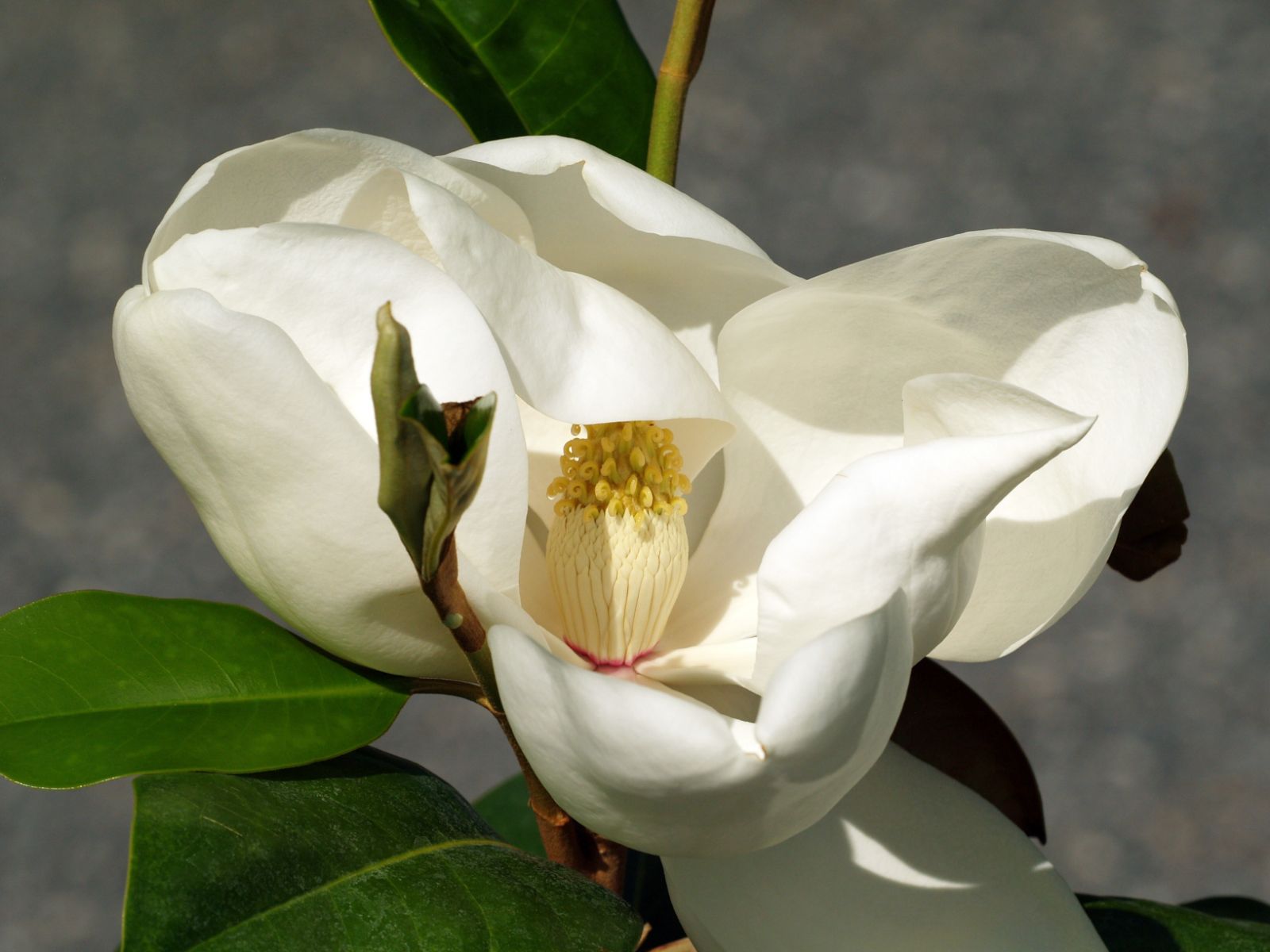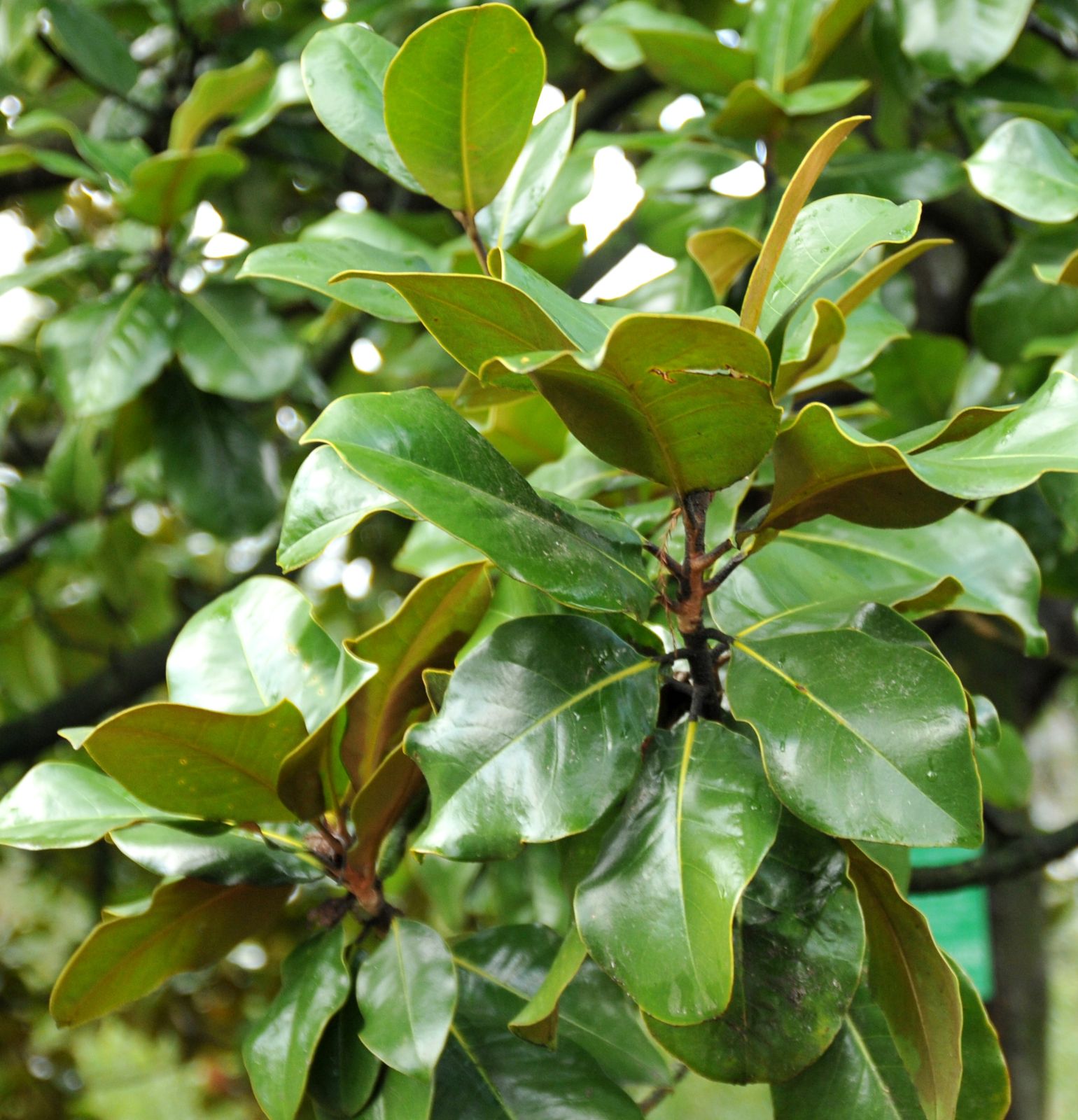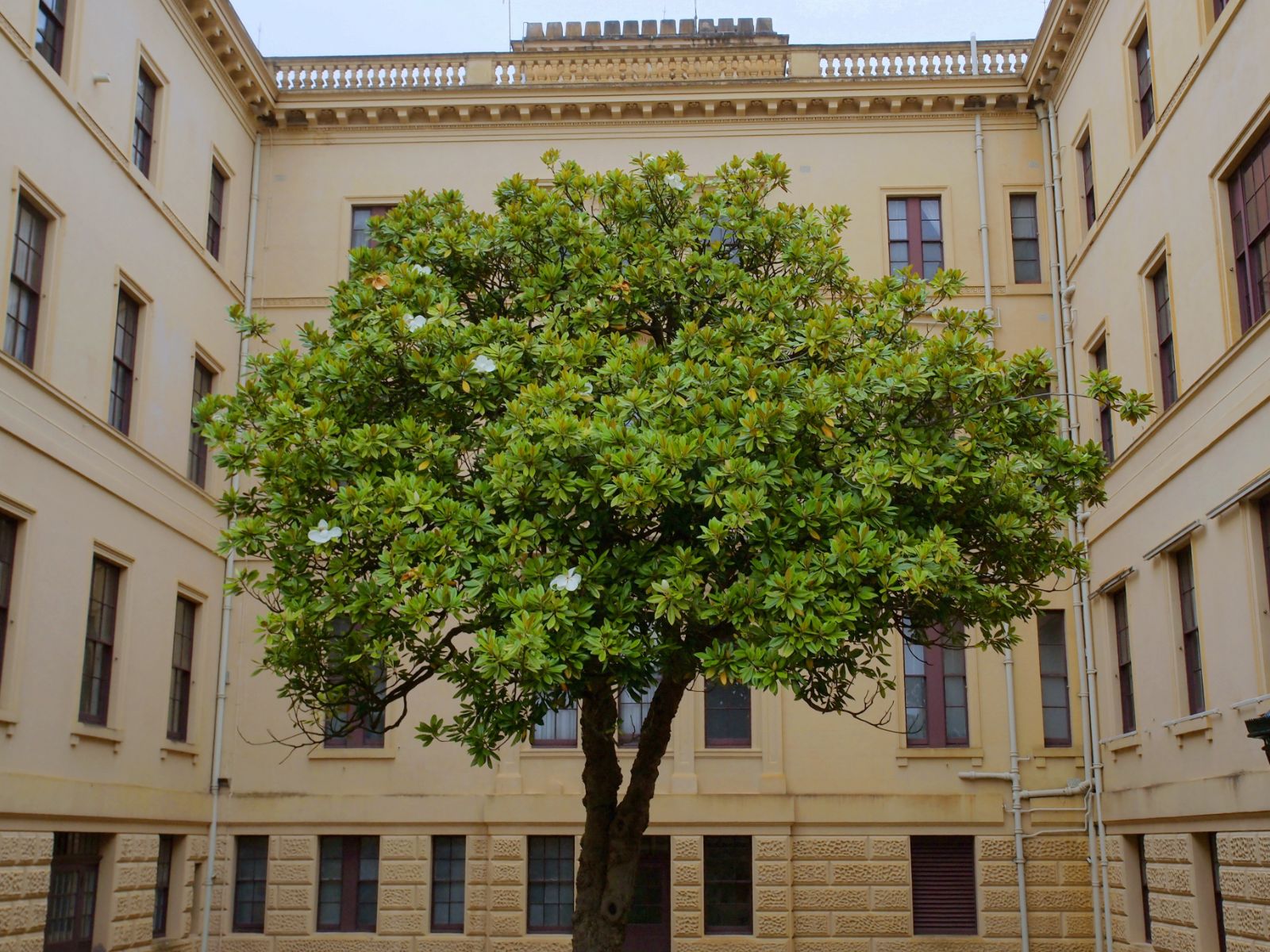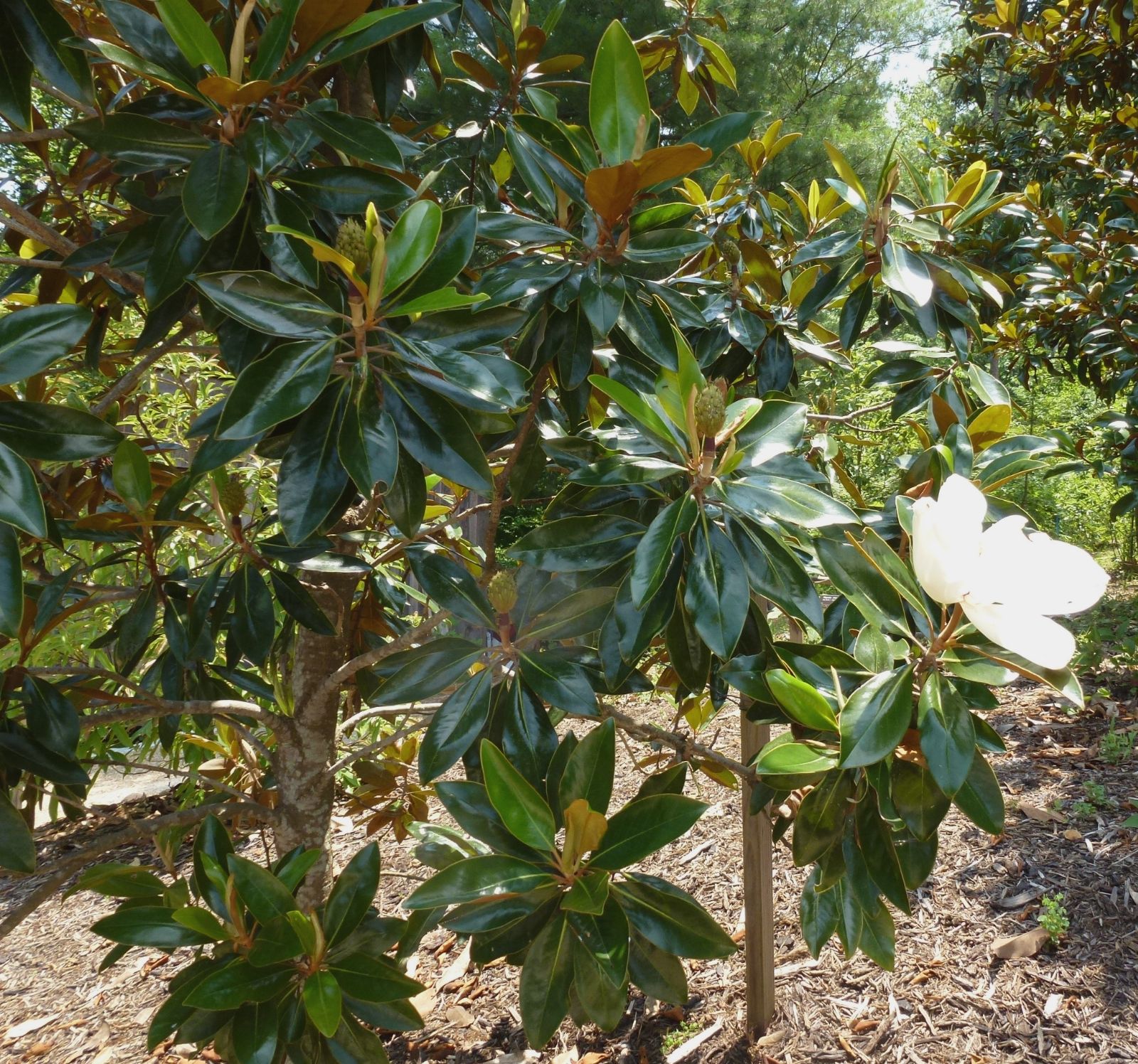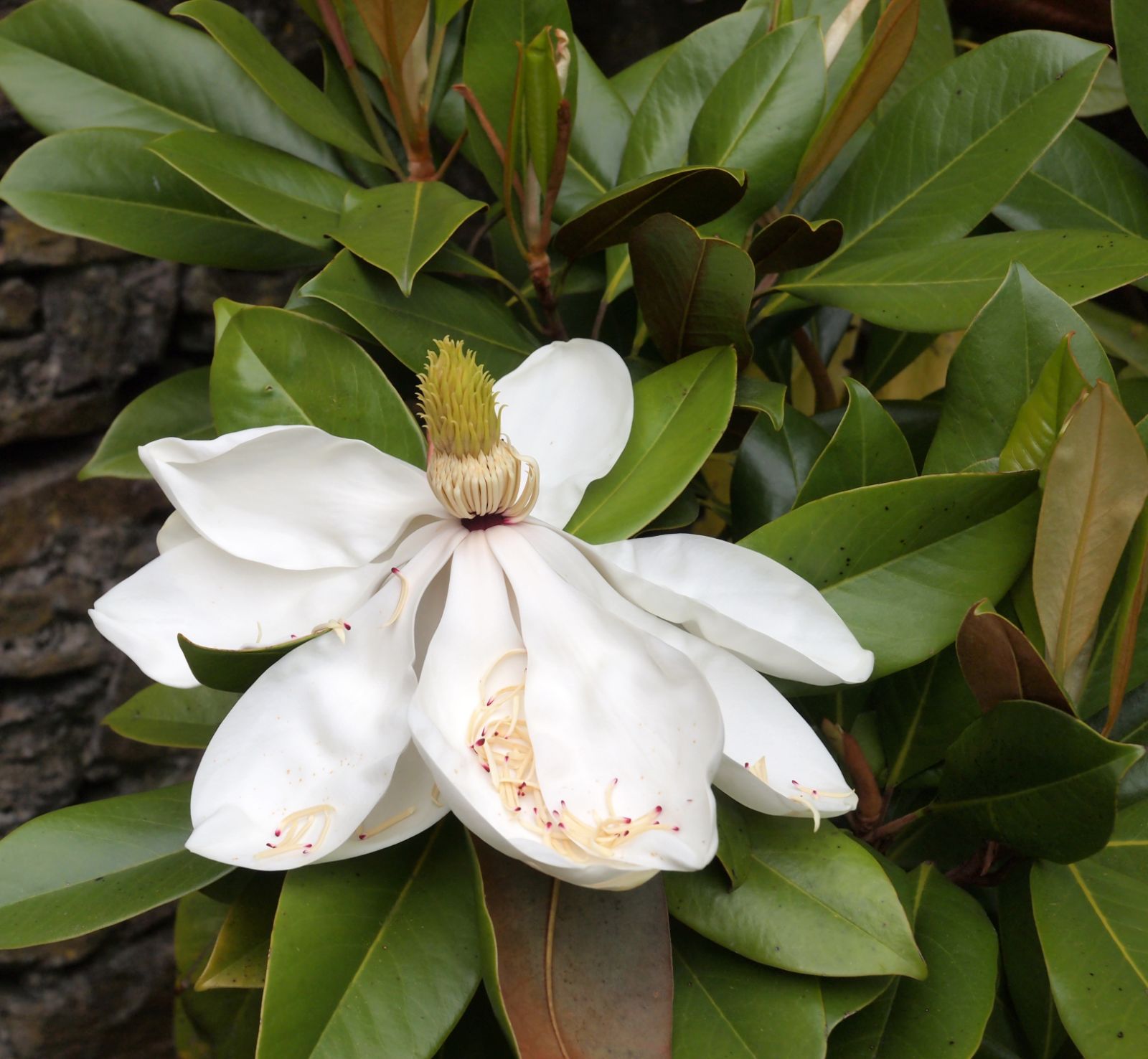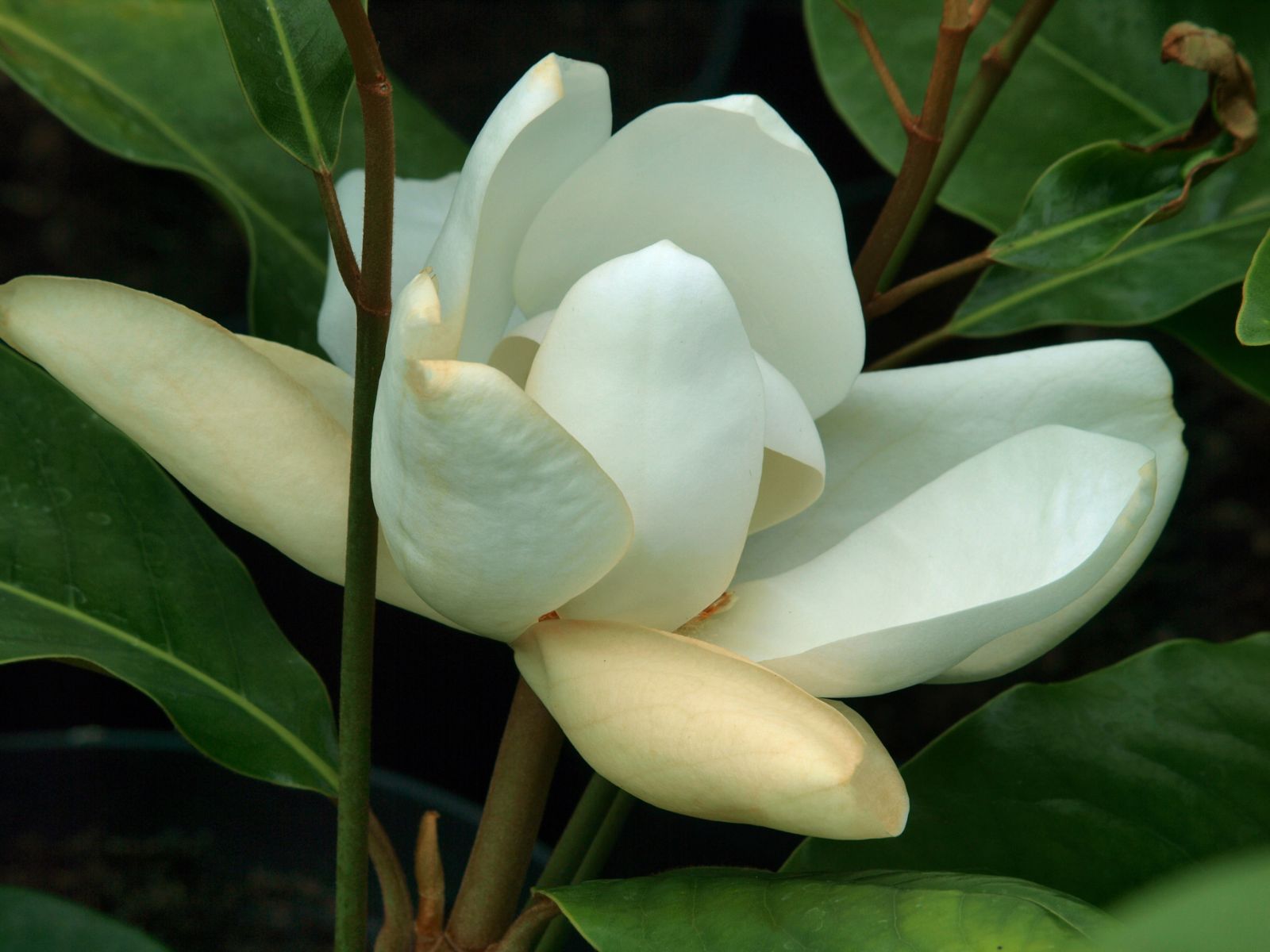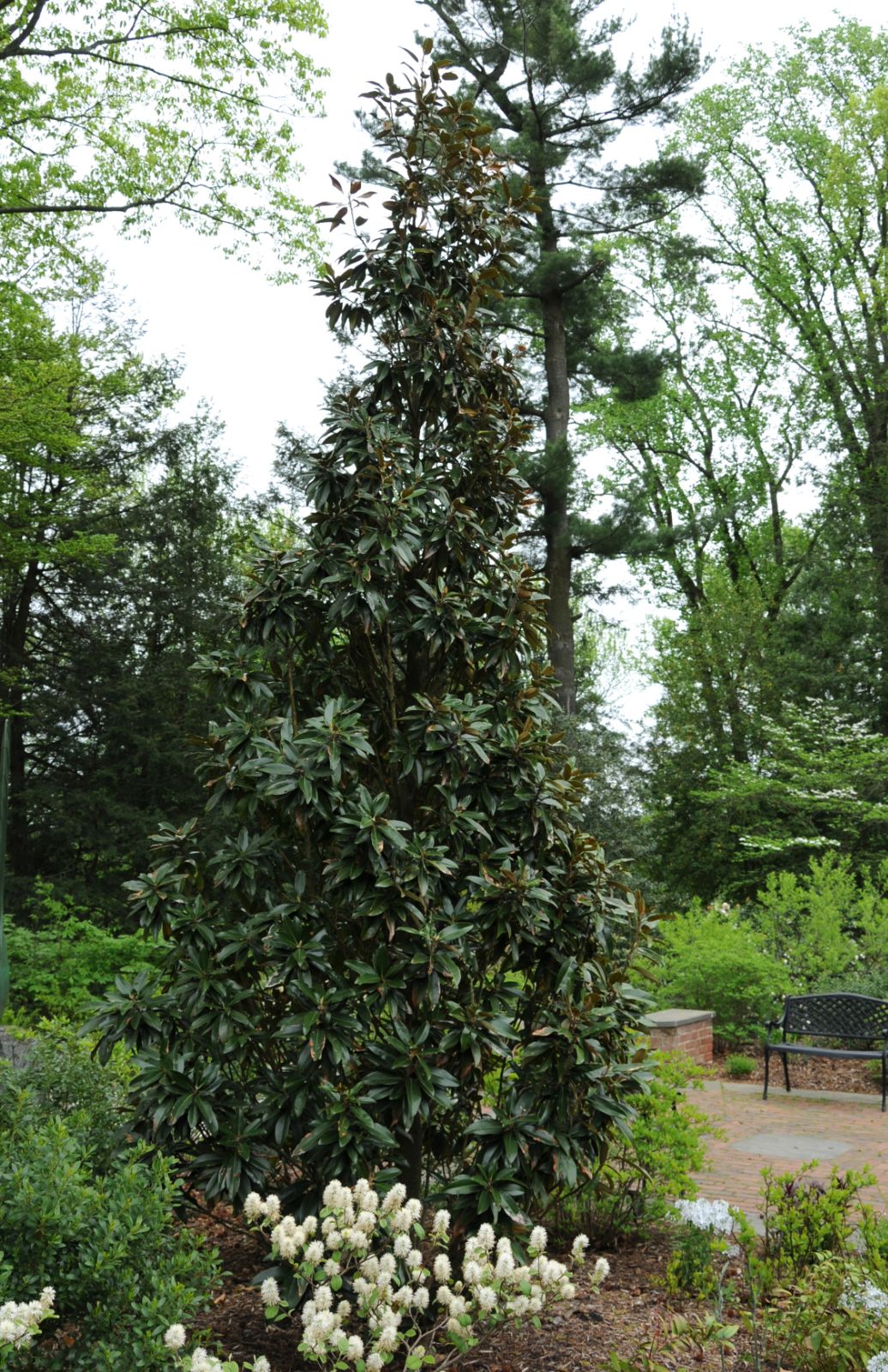Magnolia grandiflora
Sponsor
Kindly sponsored by
The Roy Overland Charitable Trust

Credits
Julian Sutton (2022)
Recommended citation
Sutton, J. (2022), 'Magnolia grandiflora' from the website Trees and Shrubs Online (treesandshrubsonline.
Genus
- Magnolia
- Section Magnolia
Common Names
- Southern Magnolia
- Bull Bay
- Loblolly Magnolia
Synonyms
- Magnolia foetida (L.) Sarg.
- Magnolia virginiana var. foetida L.
Infraspecifics
- 'Angustifolia'
- 'Bracken's Brown Beauty'
- 'Claudia Wannamaker'
- 'D.D. Blanchard'
- 'Edith Bogue'
- 'Emory'
- 'Exmouth'
- 'Ferruginea'
- 'Galissonnière'
- 'Gloriosa'
- 'Goliath'
- 'Kay Parris'
- 'Little Gem'
- 'Majestic Beauty'
- 'Monland'
- 'Nannetensis'
- 'Ruff'
- 'Russet'
- 'Saint Mary'
- 'Samuel Sommer'
- 'Southern Charm'
- 'STRgra'
- 'Symmes Select'
- 'TMGH'
- 'Victoria'
- 'Workman'
Other taxa in genus
- Magnolia acuminata
- Magnolia × alba
- Magnolia amabilis
- Magnolia amoena
- Magnolia aromatica
- Magnolia biondii
- Magnolia × brooklynensis
- Magnolia campbellii
- Magnolia cathcartii
- Magnolia cavaleriei
- Magnolia caveana
- Magnolia champaca
- Magnolia changhungtana
- Magnolia chapensis
- Magnolia compressa
- Magnolia conifera
- Magnolia Cultivars A
- Magnolia Cultivars B
- Magnolia Cultivars C
- Magnolia Cultivars D
- Magnolia Cultivars E
- Magnolia Cultivars F
- Magnolia Cultivars G
- Magnolia Cultivars H–I
- Magnolia Cultivars J
- Magnolia Cultivars K
- Magnolia Cultivars L
- Magnolia Cultivars M
- Magnolia Cultivars N–O
- Magnolia Cultivars P
- Magnolia Cultivars Q–R
- Magnolia Cultivars S
- Magnolia Cultivars T
- Magnolia Cultivars U–V
- Magnolia Cultivars W–Z
- Magnolia cylindrica
- Magnolia dandyi
- Magnolia dawsoniana
- Magnolia de Vos and Kosar hybrids
- Magnolia decidua
- Magnolia delavayi
- Magnolia denudata
- Magnolia doltsopa
- Magnolia duclouxii
- Magnolia ernestii
- Magnolia figo
- Magnolia floribunda
- Magnolia × foggii
- Magnolia fordiana
- Magnolia foveolata
- Magnolia fraseri
- Magnolia fulva
- Magnolia globosa
- Magnolia × gotoburgensis
- Magnolia grandis
- Magnolia Gresham hybrids
- Magnolia guangdongensis
- Magnolia hookeri
- Magnolia insignis
- Magnolia Jury hybrids
- Magnolia × kewensis
- Magnolia kobus
- Magnolia kwangtungensis
- Magnolia laevifolia
- Magnolia lanuginosa
- Magnolia leveilleana
- Magnolia liliiflora
- Magnolia × loebneri
- Magnolia lotungensis
- Magnolia macclurei
- Magnolia macrophylla
- Magnolia martini
- Magnolia maudiae
- Magnolia nitida
- Magnolia obovata
- Magnolia officinalis
- Magnolia opipara
- Magnolia × proctoriana
- Magnolia × pruhoniciana
- Magnolia rostrata
- Magnolia salicifolia
- Magnolia sapaensis
- Magnolia sargentiana
- Magnolia sieboldii
- Magnolia sinensis
- Magnolia sinica
- Magnolia sinostellata
- Magnolia × soulangeana
- Magnolia sprengeri
- Magnolia stellata
- Magnolia tamaulipana
- Magnolia × thomsoniana
- Magnolia tripetala
- Magnolia × veitchii
- Magnolia virginiana
- Magnolia × wieseneri
- Magnolia wilsonii
- Magnolia xinganensis
- Magnolia yunnanensis
- Magnolia yuyuanensis
- Magnolia zenii
Evergreen tree to 37 m. Bark grey, thick and rough, furrowed in thick plates. Branchlets and foliar buds densely red- or white-hairy. Leaves distinctly alternate, not in terminal whorl-like clusters; stipules 2, free, 4.5–13 × 1.5–3.5 cm, densely brown-silky beneath, sometimes deeply notched. Leaf blade narrowly to broadly elliptic or oblanceolate, (7.5–)13–20(–26) × (4.5–)6–10(–12.5) cm, thick and leathery, base narrowly cuneate, apex abruptly tapered and acute to short-acuminate, rarely obtuse; lower surface glabrous to densely red-brown felted, upper surface bright green, lustrous, glabrous. Flowers in spring in the wild, strongly lemony-fragrant, 15–30(–45) cm across; spathaceous bracts 2, leathery, outer bract brown to grayish hairy beneath, deeply notched, smaller, inner bract densely brown to grayish hairy above, shallowly notched, larger; tepals creamy white; stamens (179–)213–383(–405), 16–29 mm; filaments purple; carpels (45–)55–81(–89). Fruit cylindric to somewhat obovoid, 7–10 × 3.5–5 cm; follicles beaked, sparsely to densely silky-villous. Seeds lenticular to narrowly ellipsoid, (9–)12–14 mm, slightly grooved above, aril red. Hexaploid 2n=114. (Meyer 1997).
Distribution United States Southeastern coastal plain, from E Texas to North Carolina
Habitat Wooded dunes, river bottoms, mesic woods and ravine slopes, 0–120m.
USDA Hardiness Zone 7-9
RHS Hardiness Rating H5
Conservation status Least concern (LC)
Magnolia grandiflora is one of the great broadleaved evergreen trees of temperate zone gardens. In milder areas it can make a bulky, round headed tree, but the allure of its leathery, glossy leaves, typically with a lovely rufous indumentum beneath, and its long succession of big (sometimes huge) scented white flowers means that even in cooler areas gardeners have given over to it remarkably generous shares of precious wall space and sheltered corners. To Americans from the southern states it means much more: this plant is a symbol of the South.
Section Magnolia includes perhaps 27 species, all from Central and North America plus some Caribbean islands, but only this and two others are in anything close to general cultivation in our area, the tip of a largely tender iceberg. M. virginiana differs from M. grandiflora in being a smaller tree or shrub, deciduous in some forms, with smaller flowers and white or glaucous leaf undersides. M. tamaulipana is probably the closest relative of M. grandiflora, differing in its fewer stamens and carpels, shorter outer tepals, ‘dirtier’ flower colour and leaves with only minute hairs beneath.
The Bull Bay would have been a familiar tree to early European colonists in the South. Among the first Magnolia species to be described scientifically (Catesby 1743), Linnaeus’ specific epithet of 1759 refers to the large flowers, which had been seen in European gardens by the time Catesby was writing. It was well known to Native Americans of the southeast, bark extracts being used by the Choctaw and Kosati to treat swellings, itching and sores (Moerman 2021). Pre-colonial uses of the wood seem not to have been recorded. The timber is straight grained and easily worked, but not very durable. A light creamy colour, its main uses are in plywood and furniture frames, and as a veneer (Meier 2008).
In form this is a most variable tree. While it makes small scrubby plants growing among sand dunes overlooking the Gulf of Mexico, it is most often a large tree of rich, moist, well-drained soils (Outcalt 1990). Form and growth rate of seedlings is ‘incredibly variable’ (Gilman & Watson 1994): some are dense, making good screens, while others have widely spaced branches; some are as wide as they are tall, others almost columnar. Of several American champions, two have short, stout trunks branching low down to form wide crowns (in Smith Co., TX, 22.6 m × 635 cm, crown spread 24.4 m, 2020; and in Sussex Co, VA, 18.6 m × 676 cm, crown spread 18.6 m, 2016). A quite differently proportioned single-trunked tree in George Co., MS was measured at 33.8 m × 279 cm in 2012, its sparse crown spreading 21 m (American Forests 2021).
The foliage is notably heat-, wind- and drought-tolerant by the standards of large-leaved evergreens (Treseder 1978). Drought tolerance of the tree as a whole is better when there is space for a large root system to develop; good water availability is ideal, especially when grown in full sun (Gilman & Watson 1994). In SE Europe, Vastag et al. (2020) found the species’ physiological responses to drought much better than those of M. × soulangeana, which is far more often used locally in urban plantings, something to be borne in mind with climate change. The indumentum on the lower leaf surface might be expected to reduce transpiration. However, it is developed to a very variable extent. Cultivars with conspicuous indumentum have been selected for ornament, but studies of this variation in relation to drought tolerance and climate seem to be lacking. It is tolerant of alkaline soils, even thin soils on chalk in S England.
The flowers have a voluptuous lemon-like fragrance; their size is in keeping with the majestic foliage but again varies between clones, to 45 cm across in extreme examples. They vary in tepal number (9–15) and last 2–4 days, being cup-shaped on the first (female-fertile) day and saucer-shaped on the second (male-fertile). The stamens begin to fall during the male phase, making the flower appear less perfect. Many authors have focussed on beetles as pollinators of M. grandiflora (Thien 1974). However, a study in Louisiana populations found that bees (both indigenous species and honey bees) were more frequent visitors and effective pollinators whose behaviours correlated with changes through the life of individual flowers (Allain, Zavada & Matthews 1999). In North America the spring to summer flowering period is often more extended in garden plants (Jacobson 1996). In the maritime climate of the British Isles, late summer and early autumn is typical.
The red fruits are an ornamental feature in warmer climates, but are seldom produced in the cooler summers of Britain. The cultivar ‘Charles Dickens’ (probably a close hybrid, but often listed under M. grandiflora) is perhaps a better bet for conspicuous fruiting in maritime Europe. In the wild, seed is spread by birds and mammals, but sometimes also by water after heavy rain (Outcalt 1990). The fallen fruit ‘cones’ and large dry leaves are considered messy by the tidy-minded, and certainly do take a long time to decompose, but this seems a small price to pay for growing such a beautiful tree.
Seed was once the usual means of propagation in North America, with grafting a minority pursuit, but techniques for rooting cuttings are now well developed, allowing ready distribution of cultivars (Dirr 2009). Time from seed to flowering varies greatly between seedlings. Layering is also possible: the practice of pegging down the lower branches of specimens beside early Southern homesteads perhaps not only generated new plants but helped stabilize the tree in storms.
Southern Magnolia has come to symbolize the American South, which is as much a social construct as it is a geographical area. Inclusion of the word ‘Magnolia’ in a book or film title goes a long way towards establishing a setting, while characteristically Southern ideas and behaviours are said to come from ‘behind the magnolia curtain’ (Jackson 2017). It is the State Flower of both Mississippi and Louisiana, and its symbolism transcends the controversy around use of Confederate imagery, illustrated by the history of the Mississippi State Flag. On its secession from the United States in 1861, the state adopted a flag featuring a flowering magnolia tree – a statement of Southern distinctiveness – which was used through the Civil War. Throughout the 20th century, the flag carried instead the Confederate battle insignia, a source of increasing controversy, but this was replaced in 2021 by a design centred around the unifying image of a magnolia flower (Wikipedia 2021).
M. grandilfora was introduced to the British Isles early in the 18th century, certainly before 1728 (Treseder 1978), and probably around the same time to France and Spain. Until the advent of the Chinese M. delavayi it was the only really evergreen hardy magnolia available (Bean 1981). While it makes an admirable wall shrub, appreciating warmth and able to regenerate well after heavy pruning, it is widely hardy in the open in Britain, given sun and shelter. Most older examples probably represent a few early cultivars, such as ‘Exmouth’. Free-standing specimens are mostly in southern and western areas, including a lawn specimen at Powderham Castle (probably the same one mentioned by Loudon (1838) as already being 9 m tall) measuring 10 m × 264 cm in 2001 (The Tree Register 2021). In colder central areas, large specimens are more likely to be on a wall, for example at Leicester University Botanic Garden (10 m × 112 cm, 2015). For its extreme height, a specimen on a free-standing wall at Castlelough House, Co. Tipperary, Ireland is noteworthy (14 m × 186 cm, 2010 – The Tree Register 2021). Relatively low summer temperatures and the tendency of branches to break under heavy snow (Bean 1981) probably restrict its ultimate height in Britain.
Much taller specimens can be seen on the French Riviera and in N Italy. For example, a tree believed to date from the 1740s at Villa Zava, Vittorio Veneto (to the north of Venice) has estimated measurements of 19 m × 528 cm (2011/2016 – monumentaltrees.com 2021). The species is widely grown in the Low Countries – Arboretum Provinciaal Domein Bokrijk, Belgium holds a notable collection of cultivars (Plantcol 2021) – and into Germany, but Scandinavia seems to be a step too far even for hardier cultivars.
A classic for landscape plantings on the southern fringe of our American area, it can be grown up the Pacific coast as far as British Columbia, and on the eastern seaboard as far as the Boston area. Hardier cultivars are recommended for zone 6 (eg the St Louis area – Missouri Botanical Garden 2021). In Zone 5b this species is ‘something of a Holy Grail to the Zonal Denial Crowd’ (Cover 2004), but can be no more than an experimental plant for sheltered spots.
The experimental hybrids ‘Freeman’ and ‘Maryland’ confirm that M. grandiflora will cross with the diploid M. virginiana. Natural hybrids have been suspected where their ranges meet (Meyer 1997).
Cultivars fall into two main groups. A few old clones are of European origin, reflecting vegetative propagation of a limited number of early introductions. The bulk are of American origin, widely distributed only since the 1970s when clonal propagation became frequent, and reflect the species’ diversity of crown form, hardiness, leaf indumentum and floral characters.
'Angustifolia'
Narrower lanceolate leaves, to 20 × 11 cm, glossy green above, with a light cinnamon colouring beneath which disappears with age. It originated in France before 1817 and probably reached Britain via Caledonia Nurseries, Guernsey.
'Bracken's Brown Beauty'
USDA Hardiness Zone: 6-9
Dense pyramidal habit, prolific flowering and attractive brown indumentum on the leaf underside. Leaves to 12.5 cm long, but flowers only 12.5–15 cm across. One of the hardiest, worth attempting in a sheleterd spot in zone 5b (Missouri Botanical Garden 2021), and regarded as worthwhile from a Belgian perspective (P. de Spoelberch pers. comm. 2021). Selected 1968 by Ray Bracken on his nursery in Easley, SC.
'Claudia Wannamaker'
Upright pyramidal habit, with small elliptic leaves to 17.5 × 7.5 cm and miniature flowers about one third the size of ‘normal’ M. grandiflora, to 9 cm across. However, it flowers more or less continuously over a 5 month period from May in the southern United States, where it is widely used in landscape plantings. Selected before 1989 by Johnny Brailsford of Shady Grove Nursery, Orangeburg, SC, and named for his cousin.
'D.D. Blanchard'
Synonyms / alternative names
Magnolia grandiflora 'Brown Velvet'
Intense copper coloured indumentum on the leaf underside; compact and upright. The original tree grew in its namesake’s yard in Wallace, NC, in the early 1960s; initially distributed by Robbins Nursery, Willard, NC.
'Edith Bogue'
Broadly spreading and vigorous, with narrow dark green leaves; its major attribute is hardiness, well suited to cooler climates. John Fogg, former Director of the Morris Arboretum, reported its surviving two severe winters in Philadelphia, with temperatures as low as –31°C. Originating as a seedling in Florida, it was sent to the garden of Edith Bogue of Montclair, NJ in 1920.
'Emory'
An exceptionally fastigiate clone, whose dark green leaves have a rich brown indumentum; bowl shaped flowers of medium size. The original tree at the Louisiana State University Hilltop Arboretum was at one time 27.5 m tall, but only 3.6 m wide.
'Exmouth'
Vigorous and erect, with elliptic leaves waxy green above and with a reddish-brown indumentum beneath, the latter lost with age. Flowers extremely large, occasionally with up to 20 tepals; they appear from a very early age. The oldest of the English cultivars, from the first introduction made the early 18th century; the original grew in the garden of Sir John Colliton of Exmouth, Devon. Most of the young plants from that introduction died in the severe winter of 1739–40, making the Exmouth tree one of the few specimens of any size in Britain at a time when demand outstripped supply. The tree was rented out to nurserymen for layering, and was accidentally felled in 1794 (Bean 1981). This is the clone most frequently planted against walls in Britain.
'Ferruginea'
Erect and compact habit; rich rust-coloured indumentum on the underside of the leaf. Flowers of typical size are produced freely when the plant is growing in a sunny site. Often recommended for chalky soils. Plants under this name were in the British nursery trade by 1804; it has been suggested that today’s plants may represent a different though similar clone (Bean 1981).
'Galissonnière'
Pyramidal crown; with russet-brown indumentum on the leaf underside. Imported to France in the 1740s by Roland-Michel Barrin de La Galissonière, governor of the French territories in North America; now one of the most popular European cultivars.
'Gloriosa'
Broad leaves, compact habit; flowers to 35 cm across, of great substance. Introduced 1856 by LeBreton, France.
'Goliath'
Bushy habit; oval leaves to 20 cm long, with little indumentum beneath. Globular flowers to 30 cm across from July to November (British Isles), and from an early age. Widely grown in the British Isles; selected by Caledonia Nurseries, Guernsey, in the early 20th century.
'Kay Parris'
Awards
AGM
Rather compact, and flowering freely from a young age throughout the season. Leaves narrow and wavy-edged, with heavy brown indumentum on the lower surface. An open-pollinated seedling of ‘Little Gem’ with heavier indumentum. Selected 1991 by Kevin Parris, SC.
'Little Gem'
Compact, narrow, columnar, to ~4 × 1.5 m in 16 years. Leaves elliptic, 12.5 × 5 cm, with a good indumentum; flowers medium sized, tending not to open flat with age. Tip dieback is common in cooler areas. Selected 1952 by Warren Steed of Candor, NC from local seed. Flowering more profusely later in the season.
'Majestic Beauty'
Upright growing, pyramidal, with very large dark green leaves and large flowers from May to July (S and W United States). Selected by Monrovia Nursery, CA; US Plant Patent 2250, 1963.
'Monland'
Synonyms / alternative names
Magnolia grandiflora TIMELESS BEAUTY™
Crown broader than tall; leaves narrow with a long petiole, glossy green above, some indumentum below. Flowers large, 25–30 cm across, with 12 tepals, profusely over a long period. The number of tepals and remontant flowering, as well as its sterility, led to suggestions that it might be a hybrid with M. virginiana, but genome size data do not support this (Parris et al. 2010). Discovered near Wetumpka, AL in the late 1960s by Bob Eiland of Charmwood Nursery, and introduced by Monrovia in 1987; the name is a blend of ‘Monrovia’ and ‘Eiland’.
'Nannetensis'
Synonyms / alternative names
Magnolia grandiflora 'Nannetensis Flore Pleno'
Large flowers, often with extra tepals giving the appearance of being double. Introduced 1865 by the Delaunay Nursery of Angers, France; the name links it to the city of Nantes, also in the Loire Valley.
'Ruff'
Vigorous and upright, with possibly the darkest red-brown indumentum on the leaf underside of any M. grandiflora. An Oregon variety, named for Wallace Ruff of Eugene, introduced 1973 by Gossler Farms.
'Russet'
Upright, pyramidal habit; leaves with rich orange-brown indumentum beneath. Flowers to 20 cm across, with 16 tepals; extremely fragrant. Selected by Maunsell van Rensellaer in 1952, from southern Californian material; introduced by the Saratoga Horticultural Foundation in 1966.
'Saint Mary'
Synonyms / alternative names
Magnolia grandiflora 'St. Mary'
Magnolia grandiflora 'Glen St. Mary'
Wavy-edged leaves with conspicuously dark indumentum beneath; a large bushy shrub. Flowers freely produced from an early age, cup shaped, about 15 cm across. Selected before 1930 at Glen St. Mary Nursery, FL, a seedling from Joseph Vestal & Son, Little Rock, AR.
'Samuel Sommer'
Growth sturdy and erect, with ascending branches. Leaves large, very glossy above, with an excellent rusty indumentum beneath. Flowers with 12 tepals, persisting for 5 or 6 days, exceptionally large even from an early age – 30 cm across initially, they can reach 39 cm in favoured locations on well-established plants. It survived tornadoes and temperatures of –12°C at Reinhardt College, GA (Treseder 1978). Selected 1952 by the Saratoga Horticultural Foundation, it was named for the President of its Board of Trustees. US Plant Patent 2015, 1961.
'Southern Charm'
Synonyms / alternative names
Magnolia grandiflora TEDDY BEAR®
Narrow pyramidal form; flowers to 13.5 cm across; lower leaf surface with well-developed indumentum. Selected 1985 as being narrower than ‘Little Gem’ and flowering from a younger age, by Bob Head, SC. US Plant Patent 13049 granted 2002 (Google Patents 2022).
'STRgra'
Synonyms / alternative names
Magnolia grandiflora BABY GRAND®
Compact and dense (but larger than ‘Little Gem’); leaves and flowers medium sized; flowering season begins early. Selected before 2001 by Edward and Patricia Strauss, New South Wales, Australia. Marketed in Australasia and North America; US Plant Patent 13851 granted 2003, Australian Plant Patent 3464 granted 2008 (Google Patents 2022).
'Symmes Select'
Compact. Leaves dark green, margins undulating, good brown indumentum. Flowers reliably over a long period. Selected before 1988 by John Symmes of Madison, GA a seedling from a tree in an Atlanta cemetery.
'TMGH'
Synonyms / alternative names
Magnolia grandiflora ALTA®
Strongly upright, narrow habit; leaves with medium brown indumentum. Selected 1993 by Thomas Strickland, a seedling from Bulloch Co., GA.
'Victoria'
Leaves with rich, rusty-red indumentum beneath. Particularly hardy, withstanding –24 ºC. Origin uncertain but pre-1930, one idea being that it was imported from Exbury, England to Victoria, BC by Layritz Nursery. Alternatively, it may have reached North America from Britain under its own name.
'Workman'
Very compact; leaves small, deep green with undulating margins and light brown indumentum. Flowers small (11 cm across) with 10–11 tepals, over an extremely long season, April to December in the southern United States. Introduced by Ken Durio of Louisiana Nursery, Opelousas before 1984.

